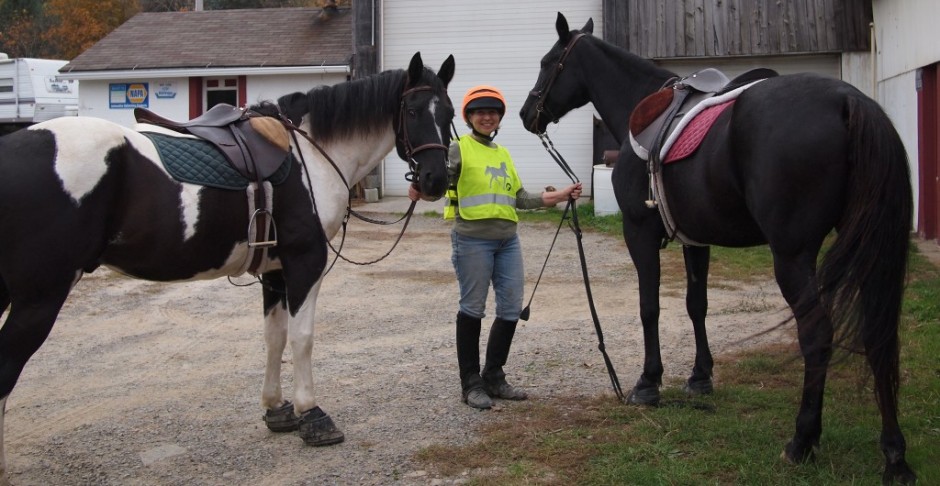Saturday turned into a warm day, a reminder of spring. I drove up to the stables and we saddled up Pepper and CJ, and then headed towards Sutliff Hill Road. At the base of the hill CJ picked up his head. He directed his ears towards a large white sign painted with thick black letters and newly hammered into the trunk of a maple tree which stood by a driveway. Immediately, he did a little hip-hop dance indicating he wasn’t going any further past the sign. I figured the best thing to do was encourage him to go up to the sign and take a good smell. That way he could familiarize himself with the object and relax. CJ balked but finally walked toward the newly painted board, and then stretched out his neck, his nostrils flared, he took a deep breath and smelled the sign. That calmed the horse. Even though he didn’t completely trust the new object tacked to the tree, he was ready to return to the road and continued our ride. I assumed that the sign frightened CJ because it was big and new. But could it be that the new paint smell caused some of his apprehension?
We rode up the street. At the top of the hill a man standing near a barn, quite a distance away, lifted a pitchfork full of hay into the air. Then, he heaved the hay into the pasture to feed his horses. CJ picked up his head, took in the smell of distant hay and quickened his pace. Unfortunately he wasn’t invited to dine. On and on we rode, occasionally CJ paused to smell a pile of horse poop at the side of the lane; maybe left by someone he knew. Briefly, I had the sensation that CJ was some kind of really big dog rather than a horse.
Perhaps when it comes to the sense of smell dogs and horses aren’t that different. Amazing as it may seem, a man named Terry Nowacki has been training police horses to track lost people and perform searches much like bloodhounds. He explains that horses can ‘air scent’; pickup a scent simply by smelling the air. Of course, horses can follow the scent by sniffing the ground too.
It may seem odd but horses have a tremendous sense of smell, far better than humans. If you look at a horse’s head, the first thing you’ll notice is the nose. The head is mostly nose and nasal passages. A horse can smell an odor in the air from a substantial distance. They use their sense of smell in many ways from predator detection to herd member recognition. Horses acknowledge each other by touching noses and taking in the scent of the other animal. This is how they greet and recognize people too.
Occasionally, when I ride in the neighborhood someone working in their yard will ask me if they can pet the horse. Before they get too close I speak to the stranger, so the horse can hear that I recognize the person as friend. And then, I tell the person to hold out their hand so the horse can smell it, just as you would when greeting a dog. During this process, I can feel the horse relax as if to say, ‘ok you can pet me now’.
A few years ago, I stood in a stall at Windy Ridge saddling a horse for my weekly lesson. Suddenly, the horse lifted his head straight up and curled his upper lip. At the time I hadn’t heard of the Flehmen response which many animals use to localize the scent of a female in heat. A mare in heat stood a few stalls away in the barn, so I assumed his weird behavior had something to do with mating rituals.
Horses perform the Flehmen response not only for breeding but also when confronted with a new or strange odor. By curling the upper lip, the animal directs the smell to the vomeronasal organ, also called Jacobson’s organ, located near the roof of their mouth. The vomeronasal organ is a chemoreceptor highly sensitive to scents and allows the horse to better analyze smells.
Truly horses are amazing creatures with highly developed sense organs. Their sight, hearing and sense of smell alert the horse to danger. As a rider it can be hard to understand what triggers a horse’s survival instinct, since at times we may not be able to hear, see or smell the threat. Possibly a good first step toward communication between horse and rider is to understand how the horse perceives his world.
Happy trails to everyone and ride safe.
Sources: Sources: http://en.wikipedia.org/wiki/Flehmen_response; http://www.dummies.com/how-to/content/understanding-a-horses-senses.html; http://horsesight.com/taste_smell.htm; http://airscentinghorse.com/home.htm
